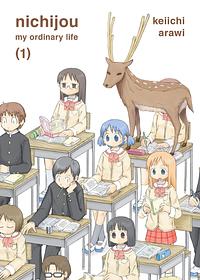You need to sign in or sign up before continuing.
Take a photo of a barcode or cover
Cute, funny, a good one to escape into for 20 minutes.
This slice-of-life school parody is delightfully stupid, absolutely absurd, and made me laugh out loud multiple times. Really enjoyed reading this and I enjoy the anime even more. If you haven't already watched the anime version, DO IT! The animators did an amazing job. Not only is it a treat to watch but the clearer action and character distinctions also make it easier to follow.
Recommended for fans of the Nichijou anime and [b:Azumanga Daioh, Vol. 1|186031|Azumanga Daioh, Vol. 1 (Azumanga Daioh, #1)|Kiyohiko Azuma|https://i.gr-assets.com/images/S/compressed.photo.goodreads.com/books/1318522097l/186031._SX50_.jpg|2440503].
Recommended for fans of the Nichijou anime and [b:Azumanga Daioh, Vol. 1|186031|Azumanga Daioh, Vol. 1 (Azumanga Daioh, #1)|Kiyohiko Azuma|https://i.gr-assets.com/images/S/compressed.photo.goodreads.com/books/1318522097l/186031._SX50_.jpg|2440503].
It feels like it's trying to be Azumanga Daioh but failing spectacularly. Azumanga Daioh was silly and quirky but Nichijou is the next level. It's so off the wall that at times it makes no sense. It's like some tryhard wanted to make quirky manga but instead it came out super irreverent.
Between this and the first volume of "Yotsuba&!," I think I've found a new favorite manga genre. They're both comedic slice-of-life short stories, but whereas "Yotsuba&!" is grounded in reality with the heartwarming comedy coming from the clash between reality and the odd worldview of its child protagonist, "Nichijou"'s comedy comes from the absurd reality in which ordinary situations become something else entirely. That chapter where the lone student observes from a hallway window as the school principal wrestles a deer? Beautiful. Excited to read more!
It's not generally my style and read more like a newspaper comic strip than a continuous story, but the characters were so endearing and I lived the way it played with the slice of life genre
funny
"The ordinary lives that all of us lead every day might perhaps be a succession of miracles."
This is the story of four ordinary high school girls living their ordinary everyday lives. Yukko, cheerful but not very bright; Mio, who’s of average intellect and has an artistic streak; the quiet and book-smart Mai; and Nano, who’s a robot with a wind-up key in her back. They all have their little quirks, and strange things happen often, but it’s all a part of ordinary life.
Nichijou (“Everyday”) is a shounen (boy’s) comedy manga that ran from 2006-2015, with an anime adaptation in 2011. There isn’t much of a narrative arc; most of the stories depict short scenes from the lives of one or more characters’ daily lives…strange as those events may be. There are some recurring themes, the most frequent of which is Nano’s desire to blend in with humans, and her frustration with her inventor/ward, eight year old mad scientist Professor Shinonome, who refuses to remove the key in her back.
In this first volume, we are introduced to the main characters as they head to school in the morning (Nano doesn’t quite make it.) Yukko tries to figure out why Mai is ignoring her. Nano has difficulties with new functions the Professor installed in her body. The pretentious Sasahara (drama club president) and hot-tempered Misato (kendo club member) try to decide what to do for the cultural festival.
There’s a school assembly led by Principal Shinonome (who may or may not be related), known for his “dad jokes” and the intensely shy Ms. Sakurai. Yukko witnesses a wrestling match between the principal and a deer–and can never tell anyone. Yukko and Mai play rock-paper-scissors. Yukko and Mio build a card house (this is a silent chapter.) Yukko fails to study for finals, and the questions seem indecipherable.
Yukko tries to finish her lunch despite dropping a key ingredient. Nano and the Professor have cake. Ms. Sakurai tries to enforce school rules on Sasahara. Mio belatedly remembers she drew an embarrassing picture in her notebook when Yukko tries to borrow it. Mio gets a part-time job that sucks. Yukko finally did her homework on time, but didn’t remember to bring it back to school. Nano suffers from over the top comedic reactions due to the Professor’s latest modifications.
The short pieces are usually funny, though some of them rely on Japanese conventions of comedy that might be opaque to newer readers of manga. The lack of focus and chapters where nothing much happens might also make this less appealing to some readers. Also, there’s some slapstick violence.
I especially like the card house chapter, which utilizes suspense and the previously established characterization to build to a silly conclusion.
The art in this first volume is less than stellar, and suffers greatly from “same face”–the artist improved greatly over the course of the series.
A word or two more about the anime: It does not present the sketches in the same order, allowing it to have a plot arc where Nano has to convince the Professor to let her attend school. It also has interspersed gags from the creator’s other series Helvetica Standard, and in the second half of the season, the closing credits feature a different song each time.
I recommend this series for fans of sketch comedy and magical realism.
This is the story of four ordinary high school girls living their ordinary everyday lives. Yukko, cheerful but not very bright; Mio, who’s of average intellect and has an artistic streak; the quiet and book-smart Mai; and Nano, who’s a robot with a wind-up key in her back. They all have their little quirks, and strange things happen often, but it’s all a part of ordinary life.
Nichijou (“Everyday”) is a shounen (boy’s) comedy manga that ran from 2006-2015, with an anime adaptation in 2011. There isn’t much of a narrative arc; most of the stories depict short scenes from the lives of one or more characters’ daily lives…strange as those events may be. There are some recurring themes, the most frequent of which is Nano’s desire to blend in with humans, and her frustration with her inventor/ward, eight year old mad scientist Professor Shinonome, who refuses to remove the key in her back.
In this first volume, we are introduced to the main characters as they head to school in the morning (Nano doesn’t quite make it.) Yukko tries to figure out why Mai is ignoring her. Nano has difficulties with new functions the Professor installed in her body. The pretentious Sasahara (drama club president) and hot-tempered Misato (kendo club member) try to decide what to do for the cultural festival.
There’s a school assembly led by Principal Shinonome (who may or may not be related), known for his “dad jokes” and the intensely shy Ms. Sakurai. Yukko witnesses a wrestling match between the principal and a deer–and can never tell anyone. Yukko and Mai play rock-paper-scissors. Yukko and Mio build a card house (this is a silent chapter.) Yukko fails to study for finals, and the questions seem indecipherable.
Yukko tries to finish her lunch despite dropping a key ingredient. Nano and the Professor have cake. Ms. Sakurai tries to enforce school rules on Sasahara. Mio belatedly remembers she drew an embarrassing picture in her notebook when Yukko tries to borrow it. Mio gets a part-time job that sucks. Yukko finally did her homework on time, but didn’t remember to bring it back to school. Nano suffers from over the top comedic reactions due to the Professor’s latest modifications.
The short pieces are usually funny, though some of them rely on Japanese conventions of comedy that might be opaque to newer readers of manga. The lack of focus and chapters where nothing much happens might also make this less appealing to some readers. Also, there’s some slapstick violence.
I especially like the card house chapter, which utilizes suspense and the previously established characterization to build to a silly conclusion.
The art in this first volume is less than stellar, and suffers greatly from “same face”–the artist improved greatly over the course of the series.
A word or two more about the anime: It does not present the sketches in the same order, allowing it to have a plot arc where Nano has to convince the Professor to let her attend school. It also has interspersed gags from the creator’s other series Helvetica Standard, and in the second half of the season, the closing credits feature a different song each time.
I recommend this series for fans of sketch comedy and magical realism.
funny
lighthearted
fast-paced





